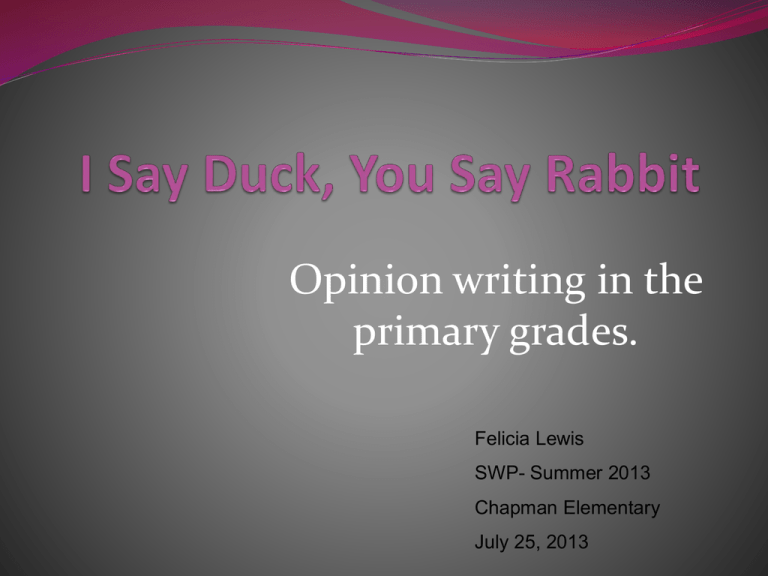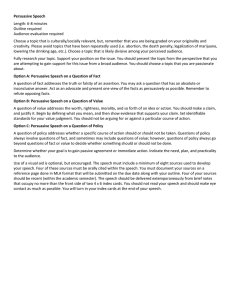I Say Duck, You Say Rabbit!
advertisement

Opinion writing in the primary grades. Felicia Lewis SWP- Summer 2013 Chapman Elementary July 25, 2013 “People do not seem to realize that their opinion of the world is also a confession of character.” ~Ralph Waldo Emerson What are ways we come into contact with opinions on a daily basis ? What does the research say? “ Argument writing is a big deal in the CCSS. If you had a hunch that this was so from its place as number one on the list of writing types.” “ While all three types are important, the standards put emphasis on the students ability to write sound arguments, as this ability is critical to college and career readiness.” ~Calkins and Lehman Pathways to the Common Core Why Persuasive Writing in Primary Grades “ We teach persuasive writing so children come to know the real- world power of writing. The persuasive writing genre opens opportunities for writers to work on several qualities of good writing.” Persuasive Writing requires writers to: Write with purpose for a selected audience Decide upon and then elaborate on the most important part of their message Write and edit for readers, making sure the text is easy to read ~Sarah Picard Taylor- Teaching Persuasive Writing My Roadblock How to teach opinion writing using rigorous forms and to prepare them for the next grade level. How to go beyond the traditional forms I have used in the past? (e.g. My favorite book is… My favorite part was… I like…) What are some helpful strategies? What mentor texts do I use to teach this effectively and how do I use them? Looking across the curriculum W.K.1- Use a combination of drawing, dictating, and writing to compose opinion pieces in which they tell a reader the topic or name of the book they are writing about and state an opinion or preference about the book ( e.g. My favorite book is…) W1.1- Write opinion pieces in which they introduce the topic or name the book they are writing about, state an opinion, supply a reason for the opinion, and provide some of closure. W.1.2- Write opinion pieces in which they introduce the topic or book they are writing about, state an opinion, supply reasons that support the opinion, using linking words (e.g., because, and, also) to connect opinion and reasons, and provide a concluding statement or section. Where do I begin? The students have to understand the difference in facts and opinions. Using mentor texts such as literary nonfiction and biographies are models of texts with numerous examples. Identifying facts and opinions in text Facts Opinions Agree or Disagree http://www.youtube.com/watch?v=hPCoe-6RRks When writing and reading opinions students must understand that because it is an opinion, there is no wrong or right answer. Also, you can agree or disagree with someone else’s opinion. Most importantly the students will have to include reasons and examples to support their opinion. Duck! Rabbit! and I Don’t Want to Be a Pea are examples of texts to use to show differences in opinions. Vocabulary Stating an Opinion Supporting an Opinion Concluding an opinion • • • • • • Because • When • The reason • • • • I think I feel My favorite part I like In my opinion I feel I would recommend I think I suggest OREO Model- Graphic Organizer Opinion- State your opinion Reasons- Give reasons to support your opinion Examples- Give examples that support your opinion Opinion- Restate your opinion http://www.haikudeck.com/p/6UpD64TQYn Example Using the story Red is Best the students will create a Haiku Deck of what they feel is best. http://www.haikudeck.com/p/6UpD64TQYn http://www.haikudeck.com/p/6UpD64TQYn Book Reviews Book reviews are a way to continue incorporating opinion writing throughout the year. http://www.kidsfirst.org/ Teaching Opinion Writing Across The Curriculum Sample for first graders Social Studies Why is Dr. Martin Luther King Jr. important enough to have his own holiday? Do you agree with Dr. Martin Luther King Jr.’s approach to civil rights? What was Benjamin Franklin’s best invention or discovery? Science What do you believe is the most powerful force? In your opinion, what part of a plant is the most essential to the life of a plant? Math After a graphing activity, have students write an opinion piece? Mini Lesson Ideas Persuasive Letters Persuasive Reviews • Providing reasons in order to persuade • Using mini-stories as reasons • Planning and persuading • Using transitional phrases • Revising • Imagining audiences • Using a word wall • • • • • • Writing catchy leads Writing strong endings Learning from mentor texts Revising with a checklist Using comparisons to persuade Editing Audience Persuade your audience not yourself. Make sure the text you offer to the reader is tailored to their needs. Would you sell this expensive two seater that you love to a family of 4? ~Gerald Graff They Say, I Say Key Points In Opinion Writing Support Evidence- Citing evidence makes your writing more credible Counterarguments- Show that you have considered arguments against your claim. Tone- Present your argument maturely. Avoid using the words always and never. Planning- If the work is well planned the focus can be on language rather than content. Editing- Check for content and confirm that the ideas are relevant and explained in enough detail for the reader to understand. Practice- By practicing students will develop skills that are useful in numerous academic and professional contents. ~ Khyati Kapai Express Yourself! Writing Persuasive Essays Closing Thoughts Questions Resources Calkins, Lucy, Mary Ehrenworth, and Christopher Lehman. Pathways to the Common Core, Accelerating Achievement. Portsmouth, NH: Heinemann. 2012. Print Common Core State Standards. Common Core State Standards Initiative. n.d. Web. 21, June, 2013. www.corestandards.org Graff, Gerald, and Cathy Birkenstein. “They Say, I Say”, The Moves that Matter in Persuasive Writing. New York. Norton, W.W & Company. 2007. iPad eBook file. Kapai, Khytai. Express Yourself! Writing Persuasive Essays: Singapore. Trafford . 2013. iPad eBook file Ray, Katie Wood. Study Driven: Portsmouth, NH. Heinemann. 2006. Print Taylor, Picard Sarah. A Quick Guide to Teaching Persuasive Writing: Portsmouth, NH. Heinemann. 2006. Print






